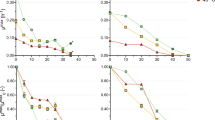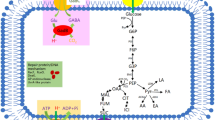Abstract
Much research has been conducted about different types of fermentation at high temperature, but only a few of them have studied cell viability changes during high-temperature fermentation. In this study, Acetobacter senegalensis, a thermo-tolerant strain, was used for gluconic acid production at 38 °C. The influences of different carbon sources and physicochemical conditions on cell viability and the resuscitation of viable but nonculturable (VBNC) cells formed during fermentation were studied. Based on the obtained results, A. senegalensis could oxidize 95 g l− 1 glucose to gluconate at 38 °C (pH 5.5, yield 83%). However, despite the availability of carbon and nitrogen sources, the specific rates of glucose consumption (qs) and gluconate production (qp) reduced progressively. Interestingly, gradual qs and qp reduction coincided with gradual decrease in cellular dehydrogenase activity, cell envelope integrity, and cell culturability as well as with the formation of VBNC cells. Entry of cells into VBNC state during stationary phase partly stemmed from high fermentation temperature and long-term oxidation of glucose, because just about 48% of VBNC cells formed during stationary phase were resuscitated by supplementing the culture medium with an alternative favorite carbon source (low concentration of ethanol) and/or reducing incubation temperature to 30 °C. This indicates that ethanol, as a favorable carbon source, supports the repair of stressed cells. Since formation of VBNC cells is often inevitable during high-temperature fermentation, using an alternative carbon source together with changing physicochemical conditions may enable the resuscitation of VBNC cells and their use for several production cycles.







Similar content being viewed by others
Abbreviations
- AAB:
-
Acetic acid bacteria
- GA:
-
Gluconic acid
- VBNC:
-
Viable but nonculturable
- rx (g l− 1 h− 1):
-
Cell growth rate
- rs (g l− 1 h− 1):
-
Substrate (glucose) consumption rate
- rp (g l− 1 h− 1):
-
Gluconic acid production rate
- μmax (h− 1):
-
Maximum specific growth rate
- qs (h− 1):
-
Specific rate of substrate (glucose) consumption
- qp (h− 1):
-
Specific rate of gluconic acid production
- qs max (h− 1):
-
Maximum specific rate of substrate (glucose) consumption
- qp max (h− 1):
-
Maximum specific rate of gluconic acid production
References
Singh OV, Kumar R (2007) Biotechnological production of gluconic acid: future implications. Appl Microbiol Biotechnol 75(4):713–722
Ajala EO, Ajala MA, Ogunniyi DS, Sunmonu MO (2016) Kinetics of gluconic acid production and cell growth in a batch bioreactor by Aspergillus niger using breadfruit hydrolysate. J Food Process Eng. doi:10.1111/jfpe.12461
Ramachandran S, Fontanille P, Pandey A, Larroche C (2006) Gluconic Acid: properties, applications and microbial production. Food Technol Biotechnol 44 (2):185–195
Anastassiadis S, Aivasidis A, Wandrey C (2003) Continuous gluconic acid production by isolated yeast-like mould strains of Aureobasidium pullulans. Appl Microbiol Biotechnol 61(2):110–117
Anastassiadis S, Rehm H-J (2006) Continuous gluconic acid production by Aureobasidium pullulans with and without biomass retention. Electron. J Biotechnol 910 (10
Saichana I, Moonmangmee D, Adachi O, Matsushita K, Toyama H (2009) Screening of thermotolerant Gluconobacter strains for production of 5-keto-D-gluconic acid and disruption of flavin adenine dinucleotide-containing D-gluconate dehydrogenase. Appl Environ Microbiol 75(13):4240–4247
Piemonte V, De Falco M, Basile A (2013) Sustainable development strategies: an overview. Sustainable development in chemical engineering: innovative technologies. John Wiley & Sons, UK
Abdel-Banat BM, Hoshida H, Ano A, Nonklang S, Akada R (2010) High-temperature fermentation: how can processes for ethanol production at high temperatures become superior to the traditional process using mesophilic yeast?. Appl Microbiol Biotechnol 85(4):861–867. doi:10.1007/s00253-009-2248-5
Bhatia L, Johri S, Ahmad R (2012) An economic and ecological perspective of ethanol production from renewable agro waste: a review. AMB Express 2 (1):1–19
Eiadpum A, Limtong S, Phisalaphong M (2012) High-temperature ethanol fermentation by immobilized coculture of Kluyveromyces marxianus and Saccharomyces cerevisiae. J Biosci Bioeng 114(3):325–329
Moreno AD, Ibarra D, Ballesteros I, González A, Ballesteros M (2013) Comparing cell viability and ethanol fermentation of the thermotolerant yeast Kluyveromyces marxianus and Saccharomyces cerevisiae on steam-exploded biomass treated with laccase. Bioresour Technol 135(0):239–245
Ndoye B, Cleenwerck I, Engelbeen K, Dubois-Dauphin R, Guiro AT, Van Trappen S, Willems A, Thonart P (2007) Acetobacter senegalensis sp. nov., a thermotolerant acetic acid bacterium isolated in Senegal (sub-Saharan Africa) from mango fruit (Mangifera indica L.). Int J Syst Evol Microbiol 57(Pt 7):1576–1581
Shafiei R, Delvigne F, Babanezhad M, Thonart P (2013) Evaluation of viability and growth of Acetobacter senegalensis under different stress conditions. Int J Food Microbiol 163(2–3):204–213
Ndoye B, Lebecque S, Destain J, Guiro AT, Thonart P (2007) A new pilot plant scale acetifier designed for vinegar production in Sub-Saharan Africa. Process Biochem 42(11):1561–1565
Shafiei R, Delvigne F, Thonart P (2013) Flow-cytometric assessment of damages to Acetobacter senegalensis during freeze-drying process and storage. Acetic Acid Bacteria 2(s1):e10
Mounir M, Shafiei R, Zarmehrkhorshid R, Hamouda A, Ismaili Alaoui M, Thonart P (2016) Simultaneous production of acetic and gluconic acids by a thermotolerant Acetobacter strain during acetous fermentation in a bioreactor. J Biosci Bioeng 121(2):166–171
Torija MJ, Rozes N, Poblet M, Guillamon JM, Mas A (2003) Effects of fermentation temperature on the strain population of Saccharomyces cerevisiae. Int J Food Microbiol 80(1):47–53
Kuřec M, Baszczyňski M, Lehnert R, Mota A, Teixeira JA, Brányik T (2009) Flow cytometry for age assessment of a yeast population and its application in beer fermentations. J Inst Brew 115(3):253–258
Müller S, Harms H, Bley T (2010) Origin and analysis of microbial population heterogeneity in bioprocesses. Curr Opin Biotechnol 21(1):100–113
Seiskari P, Linko Y-Y, Linko P (1985) Continuous production of gluconic acid by immobilized Gluconobacter oxydans cell bioreactor. Applied Microbiol Biotechnol 21(6):356–360
Narendranath NV, Power R (2005) Relationship between pH and medium dissolved solids in terms of growth and metabolism of lactobacilli and Saccharomyces cerevisiae during ethanol production. Appl Environ Microbiol 71(5):2239–2243
Song H, Jang SH, Park JM, Lee SY (2008) Modeling of batch fermentation kinetics for succinic acid production by Mannheimia succiniciproducens. Biochem Eng J 40(1):107–115
Henson MA (2003) Dynamic modeling of microbial cell populations. Curr Opin Biotechnol 14(5):460–467
Schaule G, Flemming HC, Ridgway HF (1993) Use of 5-cyano-2,3-ditolyl tetrazolium chloride for quantifying planktonic and sessile respiring bacteria in drinking water. Appl Environ Microbiol 59(11):3850–3857
Davey HM (2011) Life, death, and in-between: meanings and methods in microbiology. Appl Environ Microbiol 77(16):5571–5576
Hara S, Isoda R, Tahvanainen T, Hashidoko Y (2012) Trace amounts of Furan-2-Carboxylic Acids determine the quality of solid agar plates for bacterial culture. PloS one 7(7):e41142
Nowakowska J, Oliver JD (2013) Resistance to environmental stresses by Vibrio vulnificus in the viable but nonculturable state. FEMS Microbiol Ecol 84(1):213–222
Su CP, Jane WN, Wong HC (2013) Changes of ultrastructure and stress tolerance of Vibrio parahaemolyticus upon entering viable but nonculturable state. Int J Food Microbiol 160(3):360–366
Serpaggi V, Remize F, Recorbet G, Gaudot-Dumas E, Sequeira-Le Grand A, Alexandre H (2012) Characterization of the “viable but nonculturable” (VBNC) state in the wine spoilage yeast Brettanomyces. Food Microbiol 30(2):438–447
Quiros C, Herrero M, Garcia LA, Diaz M (2009) Quantitative approach to determining the contribution of viable but nonculturable subpopulations to malolactic fermentation processes. Appl Environ Microbiol 75(9):2977–2981
Oliver JD (2000) The viable but nonculturable state and cellular resuscitation. Microbial biosystems: new frontiers. Atlantic Canada Society for Microbial Ecology. Halifax, Canada
Vattakaven T, Bond P, Bradley G, Munn CB (2006) Differential effects of temperature and starvation on induction of the viable-but-nonculturable state in the coral pathogens Vibrio shiloi and Vibrio tasmaniensis. Appl Environ Microbiol 72(10):6508–6513
Oliver JD (2005) The viable but nonculturable state in bacteria. Journal of microbiology (Seoul, Korea) 43 Spec No:93–100
Whitesides MD, Oliver JD (1997) Resuscitation of Vibrio vulnificus from the viable but nonculturable state. Appl Environ Microbiol 63(3):1002–1005
Budu-Amoako E, Toora S, Ablett RF, Smith J (1992) Evaluation of the ability of primary selective enrichment to resuscitate heat-injured and freeze-injured Listeria monocytogenes cells. Appl Environ Microbiol 58(9):3177–3179
Morishige Y, Fujimori K, Amano F (2013) Differential resuscitative effect of pyruvate and its analogues on VBNC (Viable But Non-Culturable) Salmonella. Microbes Environ 28 (2):180–186
Busch SV, Donnelly CW (1992) Development of a repair-enrichment broth for resuscitation of heat-injured Listeria monocytogenes and Listeria innocua. Appl Environ Microbiol 58(1):14–20
Sievers M, Swings J (2005) Acetobacteriaceae. In: Garitt GM (ed) BERGEY’S manual of systematic bacteriology, vol 2 (Part C). Second edn. Springer, USA, pp 41–80
Deppenmeier U, Ehrenreich A (2009) Physiology of acetic acid bacteria in light of the genome sequence of Gluconobacter oxydans. J Mol Microbiol Biotechnol 16(1–2):69–80
Acknowledgements
The authors thank Dr. Sandra Ormenese and Mr. Raafat Stephan for their help, and scientific and technical advice in the flow-cytometric analyses.
Author information
Authors and Affiliations
Corresponding author
Additional information
R. Shafiei and R. Zarmehrkhorshid contributed equally to this work.
Electronic supplementary material
Below is the link to the electronic supplementary material.
Rights and permissions
About this article
Cite this article
Shafiei, R., Zarmehrkhorshid, R., Mounir, M. et al. Influence of carbon sources on the viability and resuscitation of Acetobacter senegalensis during high-temperature gluconic acid fermentation. Bioprocess Biosyst Eng 40, 769–780 (2017). https://doi.org/10.1007/s00449-017-1742-x
Received:
Accepted:
Published:
Issue Date:
DOI: https://doi.org/10.1007/s00449-017-1742-x




